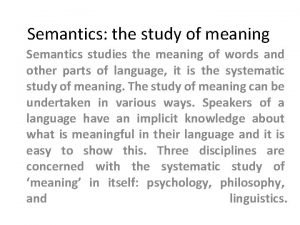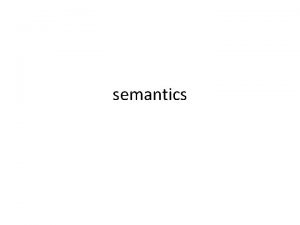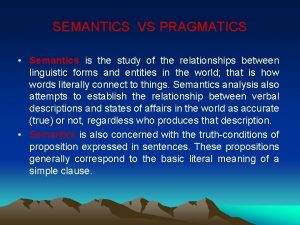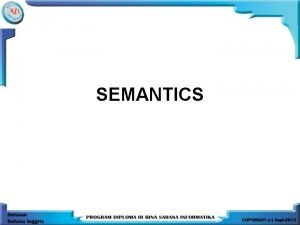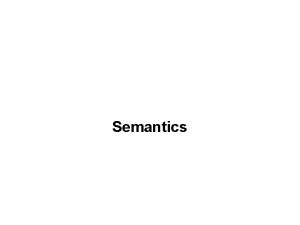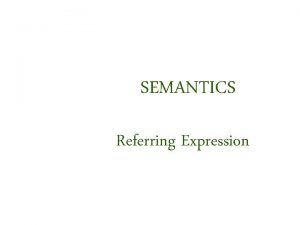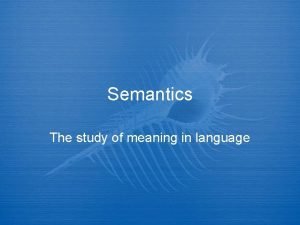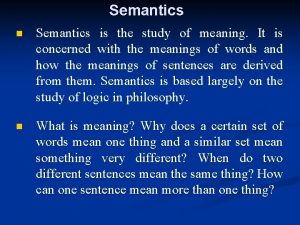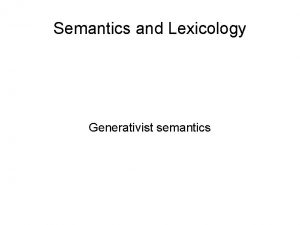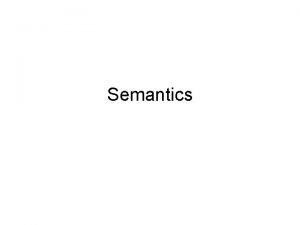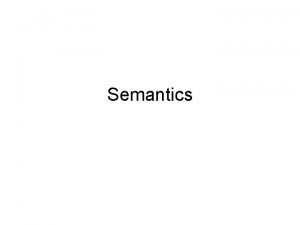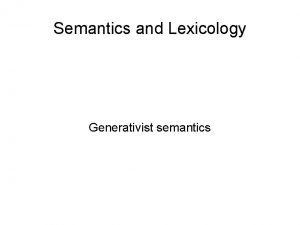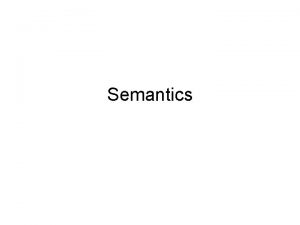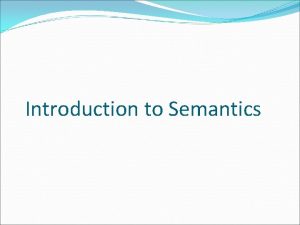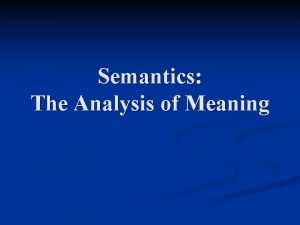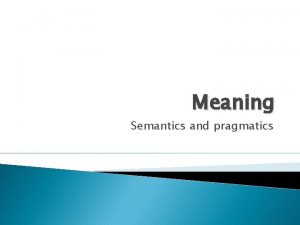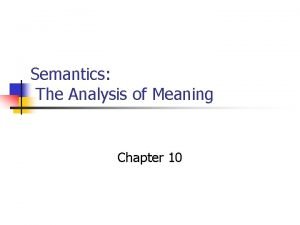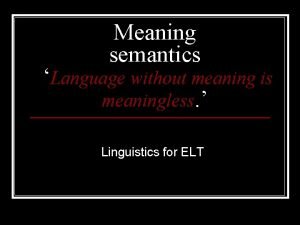Semantics n Semantics is the study of meaning
































- Slides: 32

Semantics n Semantics is the study of meaning. It is concerned with the meanings of words and how the meanings of sentences are derived from them. Semantics is based largely on the study of logic in philosophy. n What is meaning? Why does a certain set of words mean one thing and a similar set mean something very different? When do two different sentences mean the same thing? How can one sentence mean more than one thing?

Meaning is a Multifaceted Phenomenon 1. 2. Language meaning communicates information about the world around us. A language is essentially a system of symbols, and symbols are things which stand for other things. Theories of information content look at the relationship between a word and what it refers to. Language meanings are things understood and produced in the mind of the speaker/hear as he or she uses the language. Meanings are a cognitive and psychological phenomenon. The meaning of a noun like ‘bird’: is it a dictionary definition? A mental image? Or the concept of a typical bird? Theories of mental representations of meanings examine this aspect.

Meaning is a Multifaceted Phenomenon 3. Language meaning is a social phenomenon in that the relationship between speaker and hearer comes into play in determining meaning, i. e. , the Context of an Utterance, e. g. a- ‘The fish is very good today. ’ b- ‘Phew. It’s cold in here. ’ Where’s the speaker with respect to the door in the following two sentences? !! c- The door opened and two men went in d- The door opened and two men came in

Semantics n What kind of semantic knowledge does a nativespeaker have about his/her language that the linguist wants to explore? Three aspects of semantic structure of language can be thought of to answer this question: 1. The linguist tries to understand why certain words can be combined together in a semantically acceptable way, while others cannot, e. g. the two sentences below are grammatically well-formed, but the later is NOT semantically acceptable. - Hatim arrived yesterday. - Hatim arrived tomorrow.

Semantics 2. A linguist also wants to know why anyone who knows a language recognizes certain phrases and sentences as having similar meanings, e. g. - I am exhausted and I wish to sleep. - I am tired and I want to go to bed. 3. A linguist wants to know hearers not only recognize ambiguous sentences but can also use the surrounding context to choose the most likely of possible interpretations, e. g. - Visiting relatives can be very boring.

Semantics A major division in semantics is between: 1. 2. Lexical semantics: the meanings of words, and Compositional semantics: The way that the meaning of whole sentences is determined from the meanings of the individual words and the syntactic structure in which they are combined, e. g. a- The dog chased the cat b- The cat chased the dog c- The dog was chased by the cat

Approaches to the study of word meaning 1. Componential Analysis (lexical de-composition): the meaning of each lexical item is made up of certain basic semantic features. It refers to the description of the meanings of words through structured sets of sematic features which are given as ‘present’ or ‘absent’. + animate / - animate + human / - human, + adult / - adult, + male - male child, mare, stallion, hen, rooster

Componential Analysis Table Cow Girl Woman Boy Man Father Mother Animate human male Female Married Adult

Activity n Find the semantic features that distinguish each member of the following pairs: 135 - bull – cow – calf child – bull 246 - woman – cow man – child man – bull

Componential Semantics n n Componential analysis is also used with different word categories, e. g. Female is part of the meaning of the noun mother, the verb breast-feed, the adjective pregnant. ? ? The police killed James but James is not dead Cause is a verbal property of : darken, kill, solidify Semantic Property Motion Contact Creation Sense Verbs having it bring, fall, walk, run hit, kiss, touch build, make, invent see, feel, hear, watch

Lexical Semantics n Lexical Semantics deals with a language’s lexicon, or the collection of words in a language. n Lexical Relations: Relations A useful way of understanding word meaning is by studying such lexical relations as: polysemy, homonymy, synonymy, antonymy, hyponymy.

Lexical Semantics 1 - Polysemy: A lexical item is said to be polysemous if it has several meanings which are all related. n Foot: human foot, foot of a mountain, foot of a bed. n Bank: financial institution/ the building where a financial institution offers services/ it means to “rely upon” (e. g. "I'm your friend, you can bank on me") n Wood: a piece of a tree / a geographical area with many trees Head: part of the body above neck / person in charge of an institution n

Lexical Semantics 2 - Homonymy: It is a word that is written or pronounced the same way as another, but which has a different meaning. - bank - check - spring - light - fair - lie There are two types of Homonyms: 1. Homophones: words which sound the same but have different meanings and often in spelling (which and witch) , (sealing/ceiling), (meet/meat) 2. Homographs: words that are spelled the same but have different meanings and often different pronunciations (fair/fair), (wind/wind)

Activity Give at least one homonym with a different spelling of each of the following: 1 - too 2 - flee 3 - site 4 - night 5 - there 6 - sea 7 - meet 8 - pear 9 - by 10 - plane

Lexical Semantics 3 - Synonymy: Two lexical items are said to be synonymous if they have the same meaning, e. g. answer/reply, freedom/liberty, broad/wide. Perfect synonymy in English is very rare. n n Answer/reply Mary had one correct answer on the exam. Mary has one correct reply on the exam (Wrong). Carry/bear n n The policeman was carrying a gun. The letter bears no signature. Tall building/tall boy High building but NOT high boy Absolute synonymy comes with dialect variation Autumn/fall , lift/elevator, rabbit/bunny

Lexical Semantics … Activity n Give at least one synonym for each of the following: 1 - pretty 2 - mend 3 - fair 4 - admire 5 - big 6 - below 7 - relax 8 - sad 9 - start 10 - occupation

Lexical Semantics … cont’d 4 - Antonymy refers to words with opposite meanings. The basic property of two words that are antonyms is that they share all but one semantic property. Beautiful and tall are not antonyms; beautiful and ugly are antonyms as the semantic property is absent in one and present in the other.

Lexical Semantics … cont’d There are three types of antonyms 1 - Gradable antonyms: They are at the opposite ends of a continuous spectrum of meanings. They are pairs of words such as big-small, old-young, slow-fast, short-tall. These words can be interpreted in terms of being bigger or better, or older than the other item being compared. n n Comparison is made in the contexts of the same things compared. So a house is newer than another house not another car. n Non-gradable antonyms such as single-married, male-female, which do not allow expressions of degree, so we cannot say very female, quite married, more married

Lexical Semantics … cont’d n In English, the larger item of the pair is often called the unmarked or the neutral, e. g. How big is it? How tall is he? How old is she? One thousand feet high Five feet tall n These questions do not pre-judge the matter. They are not biased and open to the expectation of the inquirer. n When we ask How small is it? How young is he? How short is she? We pre-judge the matter and claim that it is in fact small, short, and young, etc. This, however, is not universal as in Japanese they would ask how short is it? How thin is it?

Lexical Semantics … cont’d 2 - Complementary Antonyms are pairs of words such as alive-dead, male-female, married-single. The absence of one implies the presence of the other. If one is not male, then one is certainly female. In certain contexts, the following can be complementary. Food drink Land sea Transitive intransitive mortal immortal n n Related to complementary pairs are sets of terms like colors where the assertion of one denies the presence of the others. If we have a set of words like red, yellow, pink, black and white. THIS IS GREEN means it is not yellow, or red, or black, etc. John is not single implies John is married

Lexical Semantics … cont’d 3 - Relational antonyms (converse antonyms): they are pairs in which one describes a relationship between two objects and the other describes the same relationship when the two objects are reversed, such as parent-child, teacher-student, doctor-patient, lendborrow, push-pull, give-take, buy-sell. n The same verb can be in a converse relationship: - John rented the house to Peter - Peter rented the house from John

Lexical Semantics … Activity n o o o o o Give the best antonym for each of the following words and decide its type: disappear true kind day dark entrance popular heavy good

Lexical Semantics … cont’d 5 - Hyponym: The meaning of one lexical item is included in the meaning of another in some type of hierarchical relationship. - A horse is a hyponym of animal. - beef is a hyponym of meat - football is a hyponym of game Living things ___________ creatures Plants animal insect vegetable flower tree horse dog snake ant cockroach poodle carrot Jasmine pine

Metaphors n Metaphor is a phrase that is not used in its usual or literal meaning but is given a different but analogous one. The essence of a metaphor is that it finds a similarity between two things that are on first consideration quite different from each other. It means to experience one kind of thing in terms of another. n Time is money= waste time, save time, spend time, run out of time, budget your time Ideas are food= thought for food, half-baked ideas, stew over ideas, digesting the facts, cannot swallow that claim Argument is war = to win or lose an argument, attack someone’s position, defend my position, your opponent or enemy, shoot down argument, claims are indefensible The sunshine of her smile = the beauty, the sweetness ﺍﻟﻮﺩﻳﺎﻥ ﺍﻟﻀﺎﺣﻜﺔ ﺍﻟﺴﻤﺎﺀ ﺍﻟﻐﺎﺿﺒﺔ ﻋﻄﺮ ﺻﺎﺭﺥ n n n Metaphors facilitate the understanding of complex or abstract domains and concepts by constructing them in terms of concrete or familiar ones.

Anger is heat metaphor 1 - With diplomacy at a standstill and anger over the Israeli campaign rising across the region … 2 - This explosion of violence would be totally understandable if the Palestinians had no alternative … 3 - The volcanic rage on both sides – intensified by the live TV coverage from the West Bank … it is spilling, like lava, out of the Middle East into Europe and beyond 4 - a move that further angered Muslims here but kept the embattled holy site from exploding anew into violent confrontation 5 - The streets in the center of the city erupted at nightfall when thousands of youths. 6 - Angry protesters flooded down the main street.

Phrasal verbs n Ø Ø n Phrasal verb is a special type of idioms which is made up of a verb followed by a preposition or an adverbial particle or both, and usually the meaning is slightly or considerably different from the literal meaning of the words. We come across something: to see or discover it. Look down on something: scorn or despise it Put up with: tolerate, endure Look after , Look up , break out , break up These structures are much more frequent in spoken English than in written English

Phrasal verbs … cont’d n They can be classified into three types depending on how much change of the verb meaning takes place with the addition of the particle(s): 1 - Transparent type: The meaning of the whole phrase is the total sum of its parts: come in ﻳﺪﺧﻞ get away ﻳﻬﺮﺏ get out of ﻳﺘﻤﻠﺺ go up ﻳﺼﻌﺪ go on ﻳﺴﺘﻤﺮ

Phrasal verbs … cont’d 2 - Semi-transparent type: the meaning of the whole phrase is not exactly the total sum of its parts, but can be guessed correctly in most cases: see off ﻳﻮﺩﻉ get away with ( ﻳﻔﻠﺖ )ﻣﻦ ﻋﻘﺎﺏ come to ﻳﻔﻴﻖ get over ﻳﺘﻐﻠﺐ ﻋﻠﻰ 3 - Opaque Type: the meaning of the phrasal verb is not the total sum of its parts and is usually very difficult to guess unless the contexts makes it very clear: see (someone) to ﻳﻌﺘﻨﻲ ﺑــ put up with ﻳﺘﺤﻤﻞ send down ( ﻳﻔﺼﻞ ﺃﻮ ﻳﻄﺮﺩ ﻃﺎﻟﺐ )ﻣﻦ ﺟﺎﻣﻌﺔ get on with ﻳﻨﺴﺠﻢ get at ﺍﻻﻗﻨﺎﻉ ﻳﺤﺎﻭﻝ

Phrasal verbs … cont’d Often one and the same phrasal verb can belong to two types: 1. 1 come across the road 1. 2 come across some old letters 2. 1 put (hand ) up = raise hand 2. 2 put up (the money ) = provide funding 2. 3 put (somebody) up = host someone 3. 1 put out (cigarette) 3. 2 put out (the cat) = leave outside 3. 3 put out (somebody) = annoy n

n n Arabic Phrasal Verbs Arabic has the same phenomenon on a large scale. But here the particle following the verb is more frequently a preposition rather than an adverbial particle. As in English the context helps in guessing the meaning of the phrase, though not always successfully. Unlike English, this phenomenon is more common in written than in spoken Arabic. Let’s consider the following examples:


Phrasal Verbs : Activity Translate the following into Arabic: 1 - Abdulla’s parents are very much set against his marriage. 2 - The drought will set the country’s progress back several years. 3 - Setting aside my wishes in this matter, what would you really like to do? 4 - The discovery of gold in California sat off a rush to go there. 5 - He is a really a good teacher; he puts across his subject very well. 6 - She was really put about when I went to see her. 7 - The army put down the rebellion in less than a week. 8 - Never put off till tomorrow what you can do today. n
 Compare procedural semantics and declarative semantics.
Compare procedural semantics and declarative semantics. Study of meanings
Study of meanings The hamburger ate the boy
The hamburger ate the boy Pragmatics vs.semantics
Pragmatics vs.semantics Hình ảnh bộ gõ cơ thể búng tay
Hình ảnh bộ gõ cơ thể búng tay Ng-html
Ng-html Bổ thể
Bổ thể Tỉ lệ cơ thể trẻ em
Tỉ lệ cơ thể trẻ em Voi kéo gỗ như thế nào
Voi kéo gỗ như thế nào Chụp tư thế worms-breton
Chụp tư thế worms-breton Chúa yêu trần thế
Chúa yêu trần thế Môn thể thao bắt đầu bằng từ đua
Môn thể thao bắt đầu bằng từ đua Thế nào là hệ số cao nhất
Thế nào là hệ số cao nhất Các châu lục và đại dương trên thế giới
Các châu lục và đại dương trên thế giới Công thức tính thế năng
Công thức tính thế năng Trời xanh đây là của chúng ta thể thơ
Trời xanh đây là của chúng ta thể thơ Cách giải mật thư tọa độ
Cách giải mật thư tọa độ 101012 bằng
101012 bằng độ dài liên kết
độ dài liên kết Các châu lục và đại dương trên thế giới
Các châu lục và đại dương trên thế giới Thơ thất ngôn tứ tuyệt đường luật
Thơ thất ngôn tứ tuyệt đường luật Quá trình desamine hóa có thể tạo ra
Quá trình desamine hóa có thể tạo ra Một số thể thơ truyền thống
Một số thể thơ truyền thống Bàn tay mà dây bẩn
Bàn tay mà dây bẩn Vẽ hình chiếu vuông góc của vật thể sau
Vẽ hình chiếu vuông góc của vật thể sau Thế nào là sự mỏi cơ
Thế nào là sự mỏi cơ đặc điểm cơ thể của người tối cổ
đặc điểm cơ thể của người tối cổ Thế nào là giọng cùng tên? *
Thế nào là giọng cùng tên? * Vẽ hình chiếu đứng bằng cạnh của vật thể
Vẽ hình chiếu đứng bằng cạnh của vật thể Tia chieu sa te
Tia chieu sa te Thẻ vin
Thẻ vin đại từ thay thế
đại từ thay thế điện thế nghỉ
điện thế nghỉ

